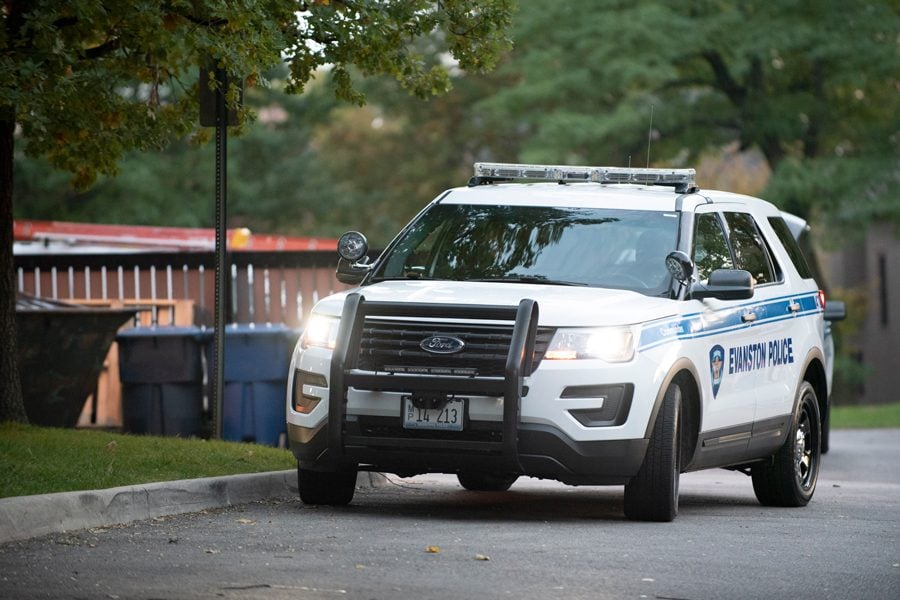Violent crime increases in Evanston, but not significantly
Daily file photo by Colin Boyle
An Evanston Police Department vehicle. The FBI said crime rates in Evanston increased this year.
November 5, 2019
Violent crime rates rose last year in Evanston, even as national levels decreased, according to data released last month by the FBI. However, the Evanston Police Department said the increase isn’t necessarily something to worry about.
Violent crimes rose by nearly 4 percent at a national level but climbed nearly 15 percent in Evanston. Robberies rose by 17.5 percent, aggravated battery increased by 7.7 percent and burglaries increased by 1.8 percent.
However, determining the significance of the change is difficult, according to Andrew Owen, a sixth-year sociology doctoral student.
“Crime is a very noisy datapoint. It changes a lot for a big variety of reasons,” Owen said, adding that those reasons may sometimes seem hard to pin down, like crime increasing during hot weather.
An increase of nearly 8 percent in cases of aggravated battery or assault marks an increase of six cases from 78 in 2017 to 84 in 2018. Robberies jumped from 40 to 47 — an increase of over 17 percent.
The numbers in Evanston are low to begin with, Owen said, which can make a percent change seem more significant.
“Because crime sort of moves around a lot from year to year, a jump in a number that small, even if it doubles, probably isn’t statistically significant,” he said.
Evanston police Cmdr. Ryan Glew said that an uptick in violent crime last year can be partially attributed to incidents like one that occurred in early 2018, where two defendants committed “quite a few robberies” at one time, which “drove up” the violent crime rate for the year.
Glew said the case was an example of one instance where the crime rate increases because of one or two people committing multiple crimes, as opposed to many people committing one crime apiece over a longer period.
Another important consideration, Glew said, was whether the Evanston police were still clearing — or charging suspects with — crimes at the same rate, even if the incidents became more frequent.
“I think our clearance rate for those 2018 violent crimes was where we would like it to be,” Glew said. “We always want it to be higher… We always want to solve all crime. But with violent crime, we strive for a high clearance rate… but realistically, I think our clearance rate was better than average.”
Glew said clearance rates for 2018 are unavailable at this time. He added that clearance rates vary across crimes: For violent crimes, the EPD has a higher clearance rate. But property crimes like burglaries and theft “a lot of times” go uncleared, Glew said.
In 2018, there were 1,358 cases of theft, making it four-and-a-half times more frequent than the next most common crime: burglary. Theft cases decreased the most by number — by 64 cases, or 4.5 percent. The number of burglaries, the second most common crime, increased numerically by 5 — from 284 in 2017 to 289 in 2018.
Theft, motor vehicle theft and arson all decreased from 2017 to 2018 — by 4.5 percent, 12.7 percent and 25 percent respectively.
“These smaller numbers can be challenging when it comes to reliability and validity,” Glew said. “(In 2019), our violent crime is down, and our property crime is up. Last year, our property crime was down and our violent crime is up.”
And crime overall in Evanston has been trending down from the late 1990s: a 2018 police report shows crime has dropped from nearly 8,000 incidents around 1997 to under 2,000 a year today.
“Obviously our goal is zero crime. Is that realistic? Probably not,” Glew said. “Our goal is to suppress crime as much as we can through traditional policing efforts, our deployment strategy, and educating the public.”
Email: theashowalter2023@u.northwestern.edu
Twitter: @theashowalter


